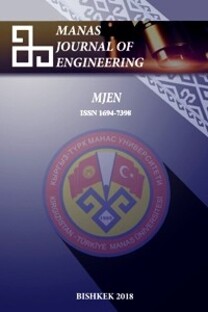Modelıng Occupatıonal Health And Safety Rısks Among Unskılled Workers In Constructıon Industry
Modelling occupational health and safety risks among unskilled workers in construction industry
___
- Davos, K. “Matching Skills and Labour Market Needs Building Social Partnerships for Better Skills and Better Jobs”. [Accessed August 2018) http://www3.weforum.org/docs/GAC/2014/WEF_GAC_Employment_MatchingSkillsLabourMarket_Report_2014.pdf (2014)
- Machin, S. “The Changing Nature of Labour Demand in the New Economy and Skill -Biased Technology Change”, Oxford Bulletin of Economics and Statistics, 63, (2001), 753-776.
- Alice, B., Tony, Z., Kerina, T.,Gicsuillermo, H. “Milieu Ltd, Brussels Occupational health and safety risk s for the most vulnerable workers”.[ Accessed 24 May, 2017] Available from ttp://www.europarl.europa.eu/document (2011).
- Bureau of Labour Statistics (BLS). “Occupational Outlook Handbook”. Edition [Accessed 24 May, 2017] Available from http://www.bls.gov/home.htm (2010)
- Occupational Health and Safety Authority “Code of Practice for the Construction Industry” [Accessed 12 June, 2016] Available from http://ohsa.org.mt/Portals/0/Docs/Useful%20Information/2016/CodePractice_Building%202006.pdf. (2006)
- Yahya, K., Hassan, A., Ebrahim, H., Narmin, H.,Hamid, B., Amir, H. B. “Factors Influencing Unsafe Behaviors and Accidents on Construction Sites: A Review”. International Journal of Occupational Safety and Ergonomics (JOSE), 20(1), (2014), 111–12
- Bureau of Labour Statistics, U.S. Department of Labour.Construction Labourers “Occupational Outlook Handbook”. [Accessed 5 January, 2009] (2008). Available from www.bls.gov/oco/ocos248.htm
- Health and Safety Executive “Employers’ perceptions of the health and safety of young” [Accessed July 24, 2016] (2015) Available from http://www.hse.gov.uk/research/rrpdf/rr1061.pdf
- Occupational Outlook Handbook (OOH). ”Bricklayers and Stonemasons” (1998). [Accessed 16 February, 2011] Available from http://www.hand-clinic.com/pop_emergency/tms.htm
- Occupational Safety and Health Branch Labour Department “Occupational health quide- Good health is good future” (2005) [Accessed August 2, 2015] Available from http://www.labour.gov.hk
- Hinze J, Pedersen C, Fredley J. “Identifying root causes of construction injuries”. Journal of Construction Engineering and Management, 124(1), (1998), 67–71.
- Occupational Safety and Health Branch LabourDepartment (2005) “Occupational health quide- Good health is good future” [Accessed 2 February, 2017] Available from http://www.labour.gov.hk
- Akomeno U. O. and Rasheed A. A. “The Lagos Megacity” [Accessed June2, 2016] Available from http://eaumega.org/wp-content/uploads/2016/05/EN-Lagos-Monograph.pdf
- Statistical Package for the SocialSciences (SPSS) (2007). “SPSS regression models [Accessed [Accessed 12 June, 2016] Available from http:/wwww.spss.com/regression
- .Adeyemi H.O,.AdejuyigbeS.BandIsmailaS.O. “Low back pain assessment application for construction workers”.Journal of Engineering, Design and Technology, 13(3), (2015), 419-434.
- Field, A. P. “Discovering statistics using IBM SPSS Statistics: And sex and drugs and rock 'n' roll” (4th ed.). (2013). London: Sage
- Veronica M., Graham B., John D. S. And Jens T. “Self-Pacing as a Protective Mechanism against the Effects of Heat Stress” Ann. Occup. Hyg., 55(5), (2011), 548–555,
- Brake, D.J, Bates, G.P. “Deep body core temperatures in industrial workers under thermal stress”, J Occup Environ Med., 44, (2002), 125–35.
- Rajeev, R., Amanda, P., Jeremy, A. “Effects of Substance Use on Workplace Injuries” [[Accessed 5 January, 2017] Available from http://www.rand.org/content/dam/rand/pubs/occasional
- Shipp, Eva M., Susan R. Tortolero, Sharon P. Cooper, Elizabeth G. Baumler, and Nancy F. Weller, “Substance Use and Occupational Injuries Among High School Students in South Texas,” American Journal of Drug and Alcohol Abuse, 31(2), (2005), 253–265.
- America’s Medicine Cabinet “Use Medicines Safely” [Accessed 15 June, 2016] Available from https://www.ismp.org/tools/ISMP-Med-Cabinet-10.pdf
- Health and Safety Executive “A guide for employers on alcohol at work”. [Accessed 5 May, 2017] Available from http://www.hse.gov.uk/pubns/indg240.pdf
- Construction Safety Council (2012) “Health Hazards in Construction Workbook“ 4100 Madison Street Hillside, IL 60162 [[Accessed 5 January, 2016] Available from 4 www.buildsafe.org
- Goetzel, R.Z, Shechter, D., Ozminkowski, R.J, Marmet, P.F, Tabrizi, M.J “Roemer EC. CME Promising Practices in Employer Health and Productivity Management Efforts: Findings From a Benchmarking Study”. Journal of Occupational and Environmental Medicine,49(2), , (2007), 111-130.
- Cook T., and Campbell D., “Impact of Work Site Health Promotion on Health Care Costs and Utilization”, Journal of Community Health, 16, (2009), 99 -117
- Labour Institute and the United Steelworkers International Union “Under grant number SH-17045-08-60-F-42 “Lessons Learned” 9(23), (2009). The Labour Institute http://www.uswtmc.org/resources/lessons-learned/lessons-learned-2009/lessons-learned-09-23.pdfpp 1-14 [Accessed 6 February, 2018)
- University of California “Shop, Tool and Electrical Safety” [Accessed 5 January, 2016] Available from http://www.ucop.edu/environment-health-safety/_files/safety-spotlight/135915.pdf
- ISSN: 1694-7398
- Yayın Aralığı: 2
- Başlangıç: 2001
- Yayıncı: KIRGIZİSTAN-TÜRKİYE MANAS ÜNİVERSİTESİ
Hilal Demir KIVRAK, Aykut ÇAĞLAR, Tulin Avcı HANSU, Ömer ŞAHİN
Arif Kivrak, Nevroz Aslan Ertas
Modelling occupational health and safety risks among unskilled workers in construction industry
Hezekiah Oluwole ADEYEMI, Olatilewa Rapheal ABOLADE, Ajibola Oluwafemi OYEDEJI, Olanrewaju Bilikis OLATUNDE
Nevroz Aslan ERTAS, Arif KIVRAK
Stability of the third order rational difference equation
Damira SAMBAEVA, Timur MAİMEKOV, Nurzat SHAYKİEVA, Janarbek IZAKO, Zarlyk MAİMEKOV
Real time traffic signal timing approach based on artificial neural network
Ali Tahir Karaşahin, Abdullah Erdal Tümer
Modelıng Occupatıonal Health And Safety Rısks Among Unskılled Workers In Constructıon Industry
Hezekiah Oluwole ADEYEMİ, Olatilewa Rapheal ABOLADE, Ajibola Oluwafemi OYEDEJI, Olanrewaju Bilikis OLATUNDE
